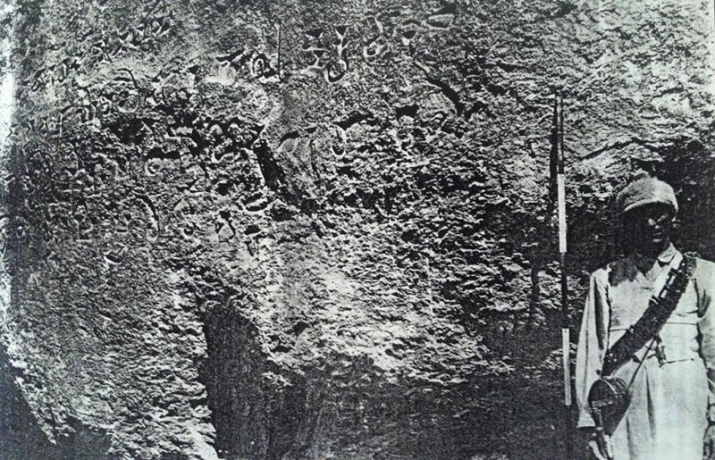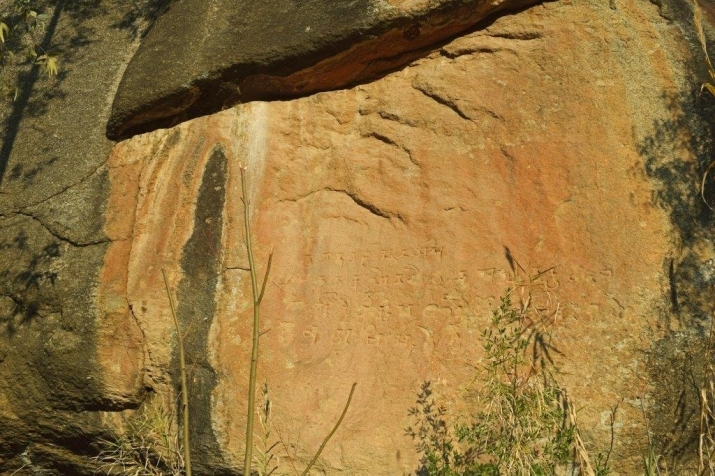NEWS
Spotlight on Buddhist Rock Inscriptions in Pakistan’s Swat Valley
 The first sutra inscription. Image courtesy of the Italian Archaeological Mission. From dawn.com
The first sutra inscription. Image courtesy of the Italian Archaeological Mission. From dawn.comThree 3rd century Buddhist rock inscriptions located by the hamlet of Jahanabad in a small valley near Shakhorai Village, within the Swat Valley administrative district of Pakistan, have made headlines recently, although local residents remain largely in the dark as to their significance and meaning.
The Swat Valley, once an active center for merchants, traders, and pilgrims as a crossroads for the ancient Silk Road trade routes, is home to a large number of Buddhist heritage sites and artifacts of great historical value, including monasteries, caves, rock-carvings, stupas, and inscriptions. More than 400 ancient stupas and monasteries can still be found within an area covering some 160 square kilometers.
Local residents say they are not aware of the significance of the three inscriptions at Jahanabad, although they recognize that they are clearly of ancient origin, according to a report in the Pakistani newspaper Dawn. One resident noted that the epigraphs had once been of great interest to Chinese and Japanese visitors, adding that the area used to be full of Buddhist relics but that many had disappeared with the passing of time.
According to Dr. Luca Maria Olivieri, head of the Italian Archaeological Mission in Swat, the inscriptions are written in Sanskrit using the Nagari script, a variant of the Gupta script, which is associated with the Gupta Empire, the latter ruling much of the subcontinent from 240–550 CE. All three inscriptions are boldly etched into rough granite in letters that vary between two and four inches in height.
The first of the three inscriptions is taken from a verse spoken, according the Mahaparinibbana Sutta, by Indra at the time of the historical Buddha Shakyamuni’s death, or according to the Mahasudassana Jataka, by the Buddha himself. It reads: “Alas! Transient are the aggregate constituents (of being) whose nature is birth and decay! For - being produced they are dissolved! - their complete cessation is bliss.” (Dawn)
 The inscriptions are written in Sanskrit using the Nagari script, a variant of the Gupta script, which is associated with the Gupta Empire, the latter ruling much of the subcontinent from 240–550 CE. Image courtesy of the Italian Archaeological Mission. From dawn.com
The inscriptions are written in Sanskrit using the Nagari script, a variant of the Gupta script, which is associated with the Gupta Empire, the latter ruling much of the subcontinent from 240–550 CE. Image courtesy of the Italian Archaeological Mission. From dawn.com“Not to commit any sin, to acquire merit, to purify one’s mind, - that is the teaching of Buddha,” reads the second inscription, a rendering of Dhammapada verse 183, while the third inscription, a rendering of Dhammapada verse 281, says: “(Let him be one) who guards his speech, is well restrained in mind, and commits no evil with his body. Keeping these three roads of action clear, one may gain the path taught by the Sages.” (Dawn)
“The tracing of the three 3rd century CE Buddhist Sutra rock inscriptions had been sent by local people in 1896 to the first Political Agent of Malakand, Major Harold Deane, who then sent them to G. Bühler for translation. They were published by the latter in 1896–1897 in the journal Epigraphia Indica, vol. IV,” Dr. Luca explained. “The lines are full of wisdom and still valid guidelines to anyone, believer or non-believer.” (Dawn)
Netizens in Pakistan echoed the concern voiced by Dawn of the lack of awareness of the heritage contained within Jahanabad. “This is [a] government responsibility to fix the translation of each inscription closer to it with its date and history so that people may understand its importance,” commented reader Abdullah. Srinivasulu Mekala noted that, “Heritage must be a factor in the identity of a nation. Like the evolutionary history of man, there is no disowning of ones [sic] ethnicity. Swat must be proud of its heritage.” (Dawn)
See more
Swatis unaware of ancient rock inscriptions’ importance (Dawn)
Valley Swat (Swat)
Rock art in the Swat Valley, Pakistan: Epigraphs (Inscriptions) (Ancient Asia)














